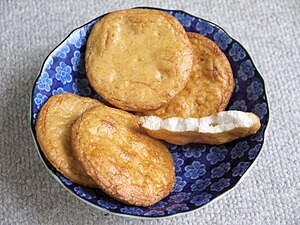
Back Senbey Azerbaijani Sembei Danish Senbei German Sembejo Esperanto Senbei Spanish سنبی Persian Senbei French Senbei ID Senbei Italian 煎餅 Japanese
This article needs additional citations for verification. (March 2013) |
 Standard senbei and a cross-section view | |
| Alternative names | Sembei |
|---|---|
| Type | Rice cracker |
| Place of origin | Japan |
| Region or state | East Asia |
| Main ingredients | Japanese rice (uruchimai) |
Senbei (煎餅, alternatively spelled sembei) are a type of Japanese rice cracker.[1] They come in various shapes, sizes, and flavors, usually savory but sometimes sweet. Senbei are often eaten with green tea as a casual snack and offered to visiting house guests as a courtesy refreshment.
There are several types of traditional Japanese senbei. They can be baked or deep-fried and sometimes sweetened. Aside from rice, wheat flour or starch can be used. Some varieties even use foods other than grains, such as sakana senbei (fish-senbei), renkon senbei (lotus root senbei) and hone senbei (bone-senbei).
Senbei have several variations, including nori-wrapped, arare, Olive no Hana, soy nut, and wet. Thin rice crackers (薄焼きせんべい usuyaki senbei) are popular in Australia and other countries.[2]
In China, the same characters used to write senbei are read jiānbǐng (煎饼; 煎餅; jiānbǐng); the term instead refers to a crepe and is more similar in preparation to okonomiyaki among Japanese foods. In Japan, senbei are hard and crispy, and are bite-sized snacks rather than street-food meals. However, crackers similar to Japanese senbei can be found in China today and their modern Chinese name is 仙贝; 仙貝; xiānbèi, which reflects the Japanese-language pronunciation of "senbei" (煎餅).
- ^ Sinclair, C (2005). "Dictionary of food: international food and cooking terms from A to Z". A&C Black.
- ^ "HISTORY". Archived from the original on April 9, 2013. Retrieved March 7, 2013.
© MMXXIII Rich X Search. We shall prevail. All rights reserved. Rich X Search